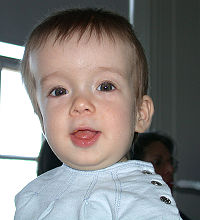
Photo from wikipedia
Abstract Acromicric dysplasia (AD) and geleophysic dysplasia (GD) are rare skeletal dysplasias characterized by short stature, acromelia, joint contracture, hepatomegaly, hoarseness and respiratory distress. Compared with GD, AD presents with… Click to show full abstract
Abstract Acromicric dysplasia (AD) and geleophysic dysplasia (GD) are rare skeletal dysplasias characterized by short stature, acromelia, joint contracture, hepatomegaly, hoarseness and respiratory distress. Compared with GD, AD presents with milder clinical and radiological features. Radiological findings of AD and GD consist of shortened tubular bones of the hands and feet, and deformed capital femoral epiphyses. The genetic cause of AD and some cases of GD was shown to be mutations in the transforming growth factor (TGF) β-binding protein-like domain 5 of the fibrillin 1 gene (FBN1), which is also mutated in Marfan syndrome. In the present study, we report and compare the highly varied clinical and radiological features of three Japanese AD/GD children. Our patients, harboring FBN1 mutations p.Tyr1699Cys, p.Ser1750Arg, and p.Gly1762Ser, shared common clinical symptoms such as severe short stature, acromelia and hepatomegaly. Short tubular bones of hands and deformities of femur heads are common radiological features of our patients.
Journal Title: Journal of Pediatric Endocrinology and Metabolism
Year Published: 2017
Link to full text (if available)
Share on Social Media: Sign Up to like & get
recommendations!